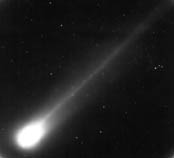
Comet tail pointing away from the sun
|
The following is the sequence of events as the comet falls towards the
sun. The nucleus warms up as it comes closer to the sun. When the nucleus is at about the
distance from the sun as planet Jupiter, the temperature is right for the frozen ices to
evaporate directly to vapour and free some dust as well. These surround the comet nucleus.
It is this dust cloud that reflects sun light and the comet becomes visible. This fuzzy
ball resembles a head of hair and hence called coma, Greek for hair. If more dust
surrounds the comet nucleus, the coma appears brighter. The size of the coma increases as
the comet comes closer to the sun, and more and more dust is released. Around the time the
comet crosses the path of the earth around the sun the water ice starts to evaporate and
the comet starts to grow a tail - infact two tails! The dust is pushed away by the
radiation pressure of sun light and forms a graceful curved tail, reflecting the sun
light. This is the tail that has earned for it the name Puchal Tara in
Hindi, Val nakshatram in Tamil and Thoka chukka in Telugu! |



